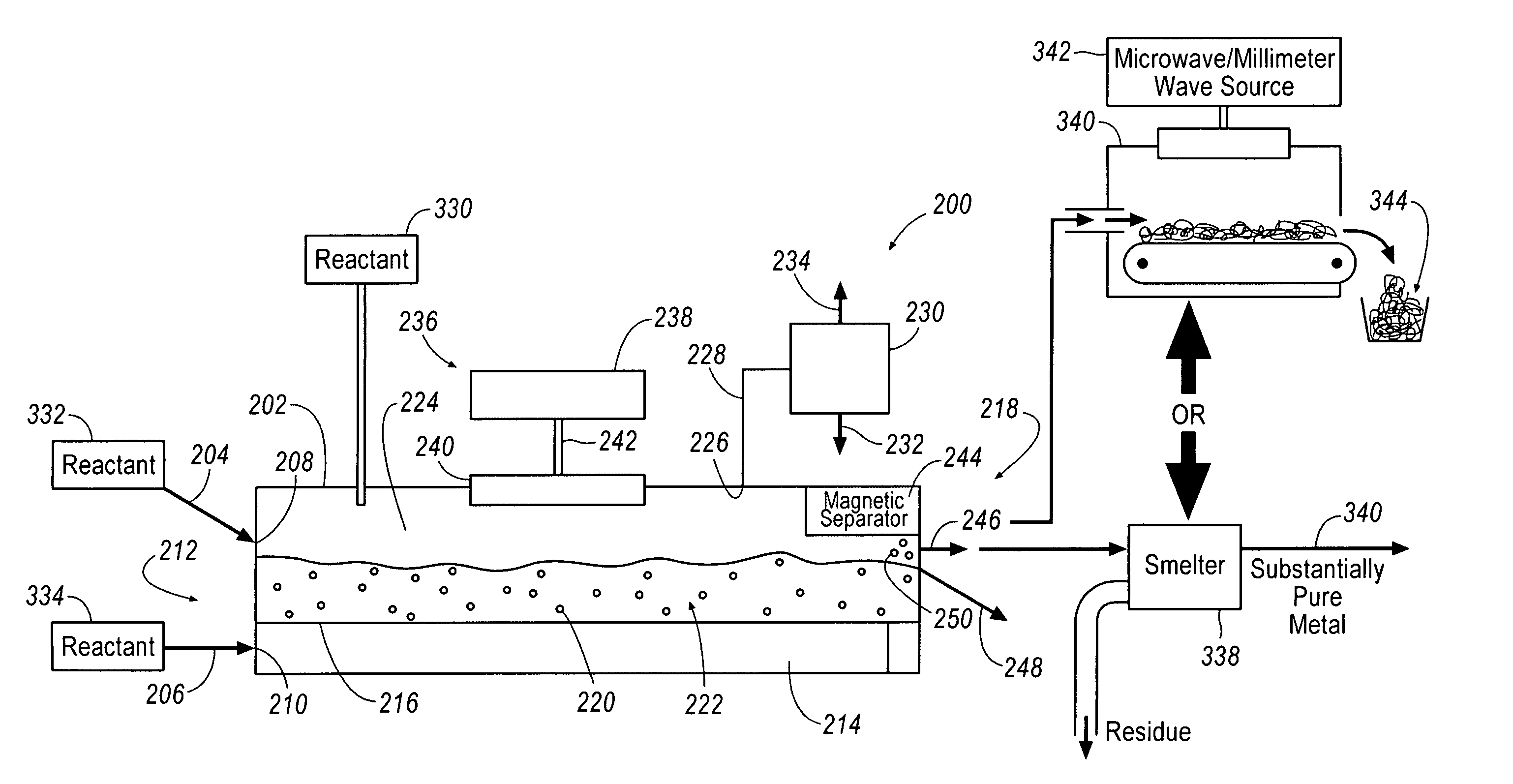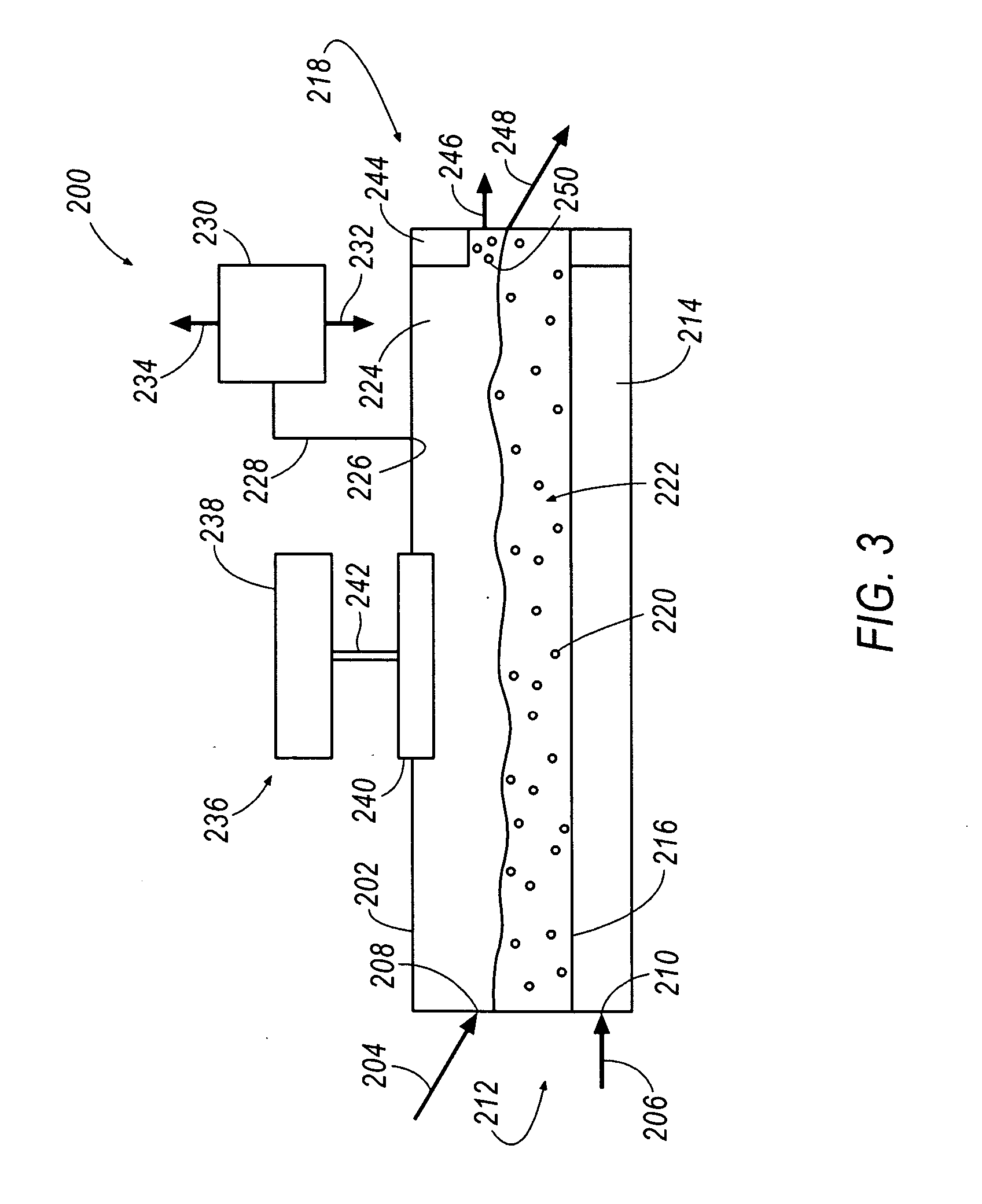[0010] The present invention provides methods and apparatuses for separating
metal values, such as nickel and
nickel compounds, from mineral ores, including lateritic ores. The inventive methods use physical processes to concentrate metal values and therefore do not raise environmental concerns associated with chemical
processing. In addition, the methods are adapted to continuously process ores, which results in lower capital outlays than batch operations. Finally, the disclosed invention utilizes electromagnetic
microwave /
millimeter wave (hereinafter “
microwave /
millimeter wave”) energy to selectively heat components of the ore, which helps conserve
energy resources.
[0011] One aspect of the invention thus provides a method of separating components of a mixture of particles, which is comprised of at least a first group of particles and a second group of particles. Group members have similar
chemical composition, while particles belonging to different groups have dissimilar chemical compositions. The method also includes exposing the mixture of particles to microwave / millimeter wave energy in order to differentially heat the first and second group of particles, thereby increasing the difference in
magnetic susceptibility between the first and second group of particles. Finally, the method comprises exposing the mixture of particles through a
magnetic field gradient, which causes the particles to separate into first and second fractions. The first and second fractions have, respectively, greater percentages of the first and second groups of particles than the mixture.
[0012] A second aspect of the invention provides a method of concentrating nickel values of a lateritic ore. The method comprises providing a lateritic ore comprised of a mixture of particles, and exposing the lateritic ore to microwave / millimeter wave energy in order to selectively heat particles that contain substantial amounts of nickel values. The
exposure to microwave / millimeter wave energy increases the difference in
magnetic susceptibility between the particles that contain substantial amounts of nickel values and particles that do not. In addition, the method includes exposing the lateritic ore through a
magnetic field gradient, which causes at least some of the particles that contain substantial amounts of nickel values to separate from the mixture of particles.
[0015] A fifth aspect of the invention thus provides a method of separating components of a mixture of particles, which is comprised of at least a first group of particles and a second group of particles. Group members have similar
chemical composition, while particles belonging to different groups have dissimilar chemical compositions. The method also includes exposing the mixture of particles to microwave / millimeter wave energy generally concurrently with exposing the mixture of particles to a reactant. The microwave / millimeter wave energy acts to differentially heat the first and second group of particles, thereby increasing the difference in magnetic susceptibility between the first and second group of particles. Additionally, the reactant enhances the magnetic susceptibility of at least one of the groups of particles. Finally, the method comprises exposing the mixture of particles through a
magnetic field gradient, which causes the particles to separate into first and second fractions. The first and second fractions have, respectively, greater percentages of the first and second groups of particles than the mixture.
[0016] A sixth aspect of the invention provides a method of concentrating nickel values of a lateritic ore. The method comprises providing a lateritic ore comprised of a mixture of particles, and exposing the lateritic ore to microwave / millimeter wave energy in order to selectively heat particles that contain substantial amounts of nickel values. Concurrently (or generally concurrently) with exposing the particles to microwave / millimeter wave energy, the particles are also exposed to a reactant. The
exposure to microwave / millimeter wave energy increases the difference in magnetic susceptibility between the particles that contain substantial amounts of nickel values and particles that do not. The magnetic susceptibility is further enhanced by the
chemical reaction between the reactant and the particles containing substantial amounts of nickel values. Further, the method includes exposing the lateritic ore to a
magnetic field gradient, which causes at least some of the particles that contain substantial amounts of nickel values to separate from the mixture of particles.
[0018] An eighth aspect of the invention provides an apparatus for continuously separating components of a mixture of particles. The apparatus includes a vessel for containing the mixture of particles during
processing. The vessel has a first end and a second end and an inlet located adjacent to the first end of the vessel that permits entry of the
solid particles into the vessel. The apparatus also includes a gas
distributor that is disposed within the vessel for fluidizing the mixture of particles, and an
energy system that is coupled to the vessel for exposing the mixture of particles to microwave / millimeter wave energy. The vessel also includes a source for exposing the particles to a reactant for enhancing the magnetic susceptibility of the particles. Finally, the apparatus also includes a
magnetic separator, which is located
proximate the second end of the vessel and which is used to separate magnetic particles from non-magnetic particles.
 Login to View More
Login to View More 


